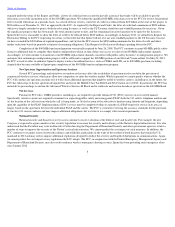Sprint - Nextel 2012 Annual Report Download - page 21
Download and view the complete annual report
Please find page 21 of the 2012 Sprint - Nextel annual report below. You can navigate through the pages in the report by either clicking on the pages listed below, or by using the keyword search tool below to find specific information within the annual report.
Table of Contents
communications technologies, products or alternative services that are superior to Sprint's technologies, products, or services or that consumers
prefer over Sprint's. If Sprint is unable to meet future advances in competing technologies on a timely basis, or at an acceptable cost, Sprint may not be
able to compete effectively and could lose subscribers to its competitors.
Some competitors and new entrants may be able to offer subscribers network features or products and services not offered by Sprint,
coverage in areas not served by Sprint's wireless networks or pricing plans that are lower than those offered by Sprint, all of which would negatively
affect Sprint's average revenue per subscriber, subscriber churn, ability to attract new subscribers, and operating costs.
The success of Sprint's network modernization plan, Network Vision, will depend on the timing, extent and cost of implementation; the
performance of third
-
parties and related parties; upgrade requirements; and the availability and reliability of the various technologies required
to provide such modernization.
Sprint must continually invest in its wireless network in order to continually improve its wireless service to meet the increasing demand for
usage of Sprint's data and other non
-
voice services and remain competitive.
Improvements in Sprint's service depend on many factors, including continued access to and deployment of adequate spectrum. Sprint
must maintain and expand its network capacity and coverage as well as the associated wireline network needed to transport voice and data between
cell sites. If Sprint is unable to obtain access to additional spectrum to increase capacity or to deploy the services subscribers desire on a timely basis
or at acceptable costs while maintaining network quality levels, Sprint's ability to retain and attract subscribers could be materially adversely affected,
which would negatively impact its operating margins.
Sprint is implementing Network Vision, which is a multi
-
year infrastructure initiative intended to reduce operating costs and provide
subscribers with an enhanced network experience by improving voice quality, coverage and data speeds, while enhancing network flexibility and
improving environmental sustainability. The focus of the plan is on upgrading the existing Sprint platform and providing flexibility for new 4G
technologies, including LTE. If Network Vision does not provide a competitive LTE network, an enhanced network experience, Sprint's ability to
provide enhanced wireless services to its subscribers, to retain and attract subscribers, and to maintain and grow its subscriber revenues could be
adversely affected.
Using a new and sophisticated technology on a very large scale entails risks. For example, deployment of new technology, including LTE,
may adversely affect the performance of existing services on Sprint's networks and result in increased churn. Should implementation of Sprint's
upgraded network be delayed or costs exceed expected amounts, its margins could be adversely affected and such effects could be material. Should
the delivery of services expected to be deployed on Sprint's upgraded network be delayed due to technological constraints, performance of third
-
party
suppliers, zoning and leasing restrictions or permit issues, or other reasons, the cost of providing such services could become higher than expected,
which could result in higher costs to customers, potentially resulting in decisions to purchase services from Sprint's competitors which would
adversely affect Sprint's revenues, profitability and cash flow from operations.
Sprint is migrating existing Nextel platform subscribers to other offerings on the Sprint platform, including existing or future offerings on
Sprint's multi
-
mode network, such as Sprint Direct Connect. The successful deployment and market acceptance of Network Vision has resulted in and
is expected to continue to result in incremental charges during the period of implementation including, but not limited to, an increase in depreciation
and amortization associated with existing assets, due to changes in Sprint's estimates of the remaining useful lives of long
-
lived assets, and the
expected timing of asset retirement obligations. Sprint's ability to transition subscribers from the Nextel platform to offerings on the Sprint platform is
dependent, in part, upon the success of Sprint Direct Connect and subscriber satisfaction with this technology.
Failure to complete development, testing and deployment of new technology that supports new services, including LTE, could affect Sprint's
ability to compete in the industry. The deployment of new technology and new service offerings could result in network degradation or the loss of
subscribers. In addition, the technology Sprint currently uses, including WiMAX, may place it at a competitive disadvantage.
Sprint develops, tests and deploys various new technologies and support systems intended to enhance Sprint's competitiveness by both
supporting new services and features and reducing the costs associated with providing those services. Successful development and implementation
of technology upgrades depend, in part, on the willingness of third parties to develop new applications or devices in a timely manner. Sprint may not
18
























